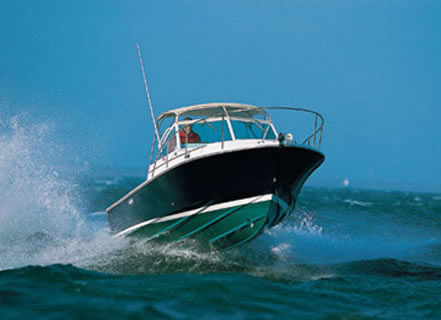The Hunt Deep-V
Developed and patented by C. Raymond Hunt in the late fifties and early sixties, the high-deadrise, or deep-V, hull is proven and accepted as the ultimate hullform for speed with comfort and safety in rough water. It is a measure of Ray's genius that today, after decades of attempts by others to conceive a better high-performance and racing hull, his original deadrise angle remains proven as the optimum.
While Hunt Design has made, and continues to discover, small refinements to this design, Ray's basic deep-V hullform offers superior characteristics that give it the ability to navigate rough seas at higher speed with more safety and comfort than any other hull design.
The sharp entry forward keeps pounding to a minimum. There is no deep forefoot to cause bow steering and broaching. The V-shape is carried all the way to the transom, resulting in evenly distributed displacement and lateral plane. These factors urge the hull to travel straight through and over the seas with only moderate steering effort, even in quartering or following seas, an extremely important safety advantage when running down waves and especially when entering rough inlets.
A high chine forward and multiple spray strips knock down spray, prevent water from climbing the topsides, add lift and reduce wetted surface. Less wetted surface means reduced resistance, greater speed and increased economy. A widely flared forward topsides encloses substantial buoyancy that reduces the potential for burying the bow or taking "solid" water over it.
At planing speeds, this hull gains stability from planing forces, so rolling is minimized. Our high-deadrise V-shape is inherently stable. As the boat tries to roll, the deep-V puts more and more hull into the water, forcing it back upright. The V-shape also allows the hull to bank in a turn, not roll outward like a round or flat-bottomed hull. And, at displacement speeds, the deep-V hull has more draft than the typical planing hull, so it behaves more surely, like a displacement hull.
The increased popularity of waterjet propulsion brings yet another set of characteristics for which the deep-V is better suited. Our long keel line helps offset the "squirrelly" directional control aspects waterjets can bring to hulls where stern sections are too flat.
For all these reasons, the Hunt deep-V hullform is the best design for speed and good seakeeping in rough waters. Nearly fifty years of experience with and continued development of this design enables C. Raymond Hunt Associates to optimize the deep-V for virtually any specific application.



